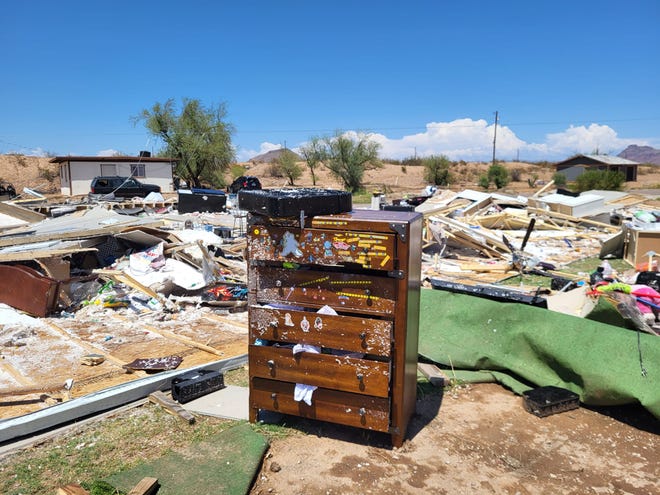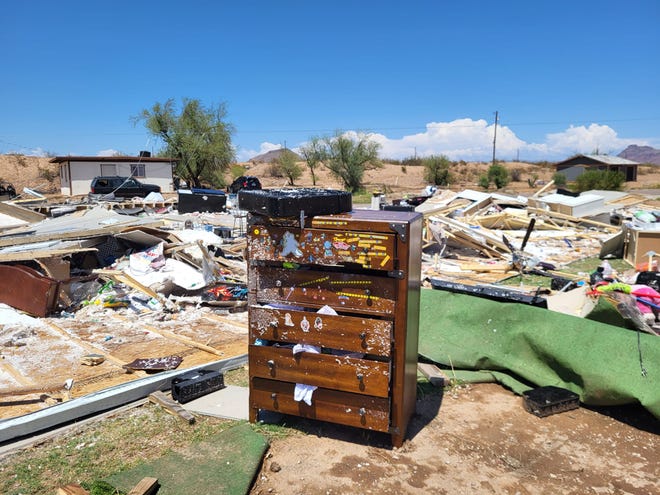

Madeline Ostrander’s “At Home on an Unruly Planet’ is a breath of fresh air in a world increasingly polluted by fossil fuels, a moment of calm in our most tempestuous existential crisis.
Through chapters chronicling four challenges Americans in different parts of the country are currently experiencing as a result of climate change, the Seattle-based journalist documents our unraveling natural world in narratives that feel like a bedtime story, interspersed with essays about the future that feel like hope.
In Part One of the 352-page book, released August 2 by Henry Holt and Company Publishers, readers learn about a community in Washington state that comes together to study and respond to worsening western wildfires; about historic preservationists in Florida racing to save one of America’s oldest cities from being claimed by rising seas; about an Alaskan village forced to flee its eroding river banks; and about residents trying to thrive amid sun-eclipsing refinery explosions in the shadow of northern California’s Mount Tamalpais.
Review:New book on climate change in national parks pleads for action to save our best idea
Part Two navigates how these regions are working to solve their problems, experienced so far in a global patchwork but created primarily by richer nations burning fossil fuels for energy, emitting greenhouse gases into the shared atmosphere that raise its average temperature.
Ostrander punctuates these somber chapters with meditations on the meaning of “home” throughout history, for both humans and other animals. In between introducing us to a community trying to avoid burning down and one struggling to stay above sea water, she walks us through the etymology of homesickness.
The term “solastalgia,” for example, invokes a combination of a sense of nostalgia for the past, the solace of a familiar place and the loneliness of being estranged from one’s homeland (even if you don’t leave but it, instead, becomes unlivable around you).
The carbon footprint debate:Climate change is not your fault, but that doesn’t mean you’re off the hook
Every chapter — nearly every page — is rich with facts, context and compelling real-life characters that help drive home the point that these situations are becoming more dire and common and that, in many cases, available solutions have been blocked or overlooked.
The book is a road map to climate empathy and an instruction manual on how and why we must all do better, together, before these carbon-driven catastrophes start lapping at the rest of our doorsteps.
Details of a disaster
With wildfire, Ostrander explains how factors dating back to Columbus’ 1492 arrival on the continent and introduction of Old World diseases resulted in Indigenous knowledge about management of wildfire-adapted ecosystems being lost, ignored or usurped.
Native populations have traditionally limited the potential for deadly and destructive wildfires by conducting purposeful, smaller burns — also called prescribed fire, Indigenous burning or good fire — to clear the landscape of the undergrowth that fuels larger modern fires.
“It’s humans’ responsibility to manage fire on our landscapes,” a California ecologist told Ostrander. “It’s how we manage for future generations. We don’t leave them a fuel-choked tinderbox.”
Many Arizona experts have echoed this evaluation as wildfires have increasingly become a social and economic burden across the West. Ostrander writes about how the 2011 Wallow Fire, still Arizona’s largest, invoked a resurgence of the term solastalgia, as interviews with survivors unveiled layers of climate grief and environmental melancholia for the sense of home that had been lost.
Wildfire woes:Rodeo-Chediski Fire forced people to flee their homes. Many returned, but with new anxiety
The story at the opposite corner of the country is no less fascinating or fretful. In St. Augustine, Florida, Ostrander’s protagonists convene experts on sea level rise in an effort to collect ideas on how to save historical buildings from worsening hurricanes and rising tides that are caused by warmer temperatures energizing storms, melting sea ice and expanding the ocean volume all at once.
At stake are several historic cemeteries that cannot be relocated, an old Spanish Fort living on borrowed time thanks to a protective sea wall and ruins of the lesser-known and less-preserved Fort Mose. The first legally recognized free Black community in what is now the United States, freedom seekers who reached Fort Mose received some measure of protection from the Spanish before St. Augustine fell to the British in 1763.
“In about two and a half decades, roughly 136 billion dollars’ worth of real estate on both the East Coast and the West Coast could suffer from chronic flooding, according to a study by the Union of Concerned Scientists,” Ostrander writes.
It will be impossible to save all of these structures, especially older and more delicate ones or those belonging to people with fewer resources. But engineering and climate solutions can buy communities like St. Augustine valuable time to strategize and prioritize the preservation of “home.”
Tracking and tackling the threat
Next, Ostrander whisks us back across the entirety of the diverse United States to a village out on Alaska’s remote Y-K Delta that is being washed away at an unsettling rate by an increasingly turbulent Ninglick River.
Newtok was one of the early communities that introduced the world to the concept of climate migration, where rising average temperatures and associated weather abnormalities force people out of traditional homelands rendered increasingly unsafe for human habitation.
Across repeated visits to Newtok during which Ostrander slept on the floor in a storage room at the school building, she gets to know the locals and record how their emotions about being forced to abandon the buildings that house their family memories ebb and flow. She sees the river advancing and chipping away at the land separating these homes from its banks, first by 20 feet, then 4 feet, then by just two steps.
On her final visit, villagers had started to leave unstable structures behind and relocate by boat to the foreign-feeling spot named Mertarvik, which the U.S. Federal Emergency Management Agency had decided would be their new home.
Climate series beginning:Phoenix isn’t what it once was because of climate change. But it’s not too late to save it
In her fourth and final climate vignette, Ostrander walks us through the troubled history and modern gardens of Richmond, California, where a hardy group fights to tend their local family roots, in spite of explosions at the nearby Chevron oil refinery that cast doubt and soot over what makes a place eventually unlivable.
In Part One, a Richmond community leader watches for the second time in her life as a black plume of smoke blots out the sun and rains down ash onto her home and community urban garden initiative. Frustrated at the lack of accountability and the environmental injustice of fossil fuel pollution affecting poor and minority communities most, she asks “Who owns the sky?”

In Part Two, Ostrander offers an answer to that question: The global atmosphere is a shared resource. But whereas the author of the “tragedy of the commons” concept would have us believe that selfish human nature will inevitably result in the destruction of any shared commodity, Ostrander offers hope.
To counter the eugenics-infused ideas behind tragedy-of-the-commons predictions, she references work by Elinor Ostrom, who compiled success stories from around the world detailing situations in which humans were able to share a natural resource while protecting it. This fresh take on an age-old human problem won the Nobel Prize in Economics in 2009, the first awarded to a woman.
This is exactly the kind of fresh viewpoint the global community will need to bring into focus if we’re going to survive the climate crisis and protect those most vulnerable, Ostrander implies. While the soot-clouded reality in Richmond is distressing, this broader outlook suggests a sunnier path forward, if we choose to take it.
Cultivating connection in chaos
Taking that proactive path forward will involve not only the democratic removal of political barriers to climate action and the immediate and widespread adoption of existing climate change solutions recommended by the Intergovernmental Panel on Climate Change, but also, according to Ostrander, a deep global meditation on the ways we have “cultivated a tendency to shut off our feelings and distract ourselves from what is, in truth, horrifying.”
What the experts recommend:Climate experts say the world ‘is at a crossroads,’ but offer hope with concrete actions
There are a lot of books about climate change already on the market. Evidence-based information outlining patterns, problems and solutions, from experts and activists and innovators and journalists, is available in spades. And yet we fail to rise to the occasion at a pace commensurate with the furious firestorms, surging seas, turbulent tides and spoiling skies.

For me, this book brought home the urgency of our predicament better than most, by centering the need to act around the non-tragic human instinct to create and protect a collective sense of “home” — a term the author examines and redefines throughout.
By appealing to our place-centered community identities and desire to defend a shared homeland, whatever the boundary of that may be, Ostrander’s bedtime-story tone resonates with our good side. In her preface, she notes that her decision to constrain her case studies to within the United States aimed to target this country’s slow response to the climate crisis, especially given its role as the largest historical emitter of climate-warming greenhouse gases.
I grew up in the West, watching wildfire size records and acres of forest I loved fall. The Girl Scout Camp where I spent summers as a child, a strong sense of home-away-from-home for me, narrowly escaped the Hayman Fire, the largest in Colorado state history in 2002 at just under 140,000 acres.
I went to graduate school for ecology in Gainesville, Florida, when Hurricanes Matthew and Irma blasted through the region and exacerbated St. Augustine’s flooding problem. These were also years during which Gov. Rick Scott banned the term “climate change” from official use, in what felt like the most blatant possible example of burying one’s head in the sand in hopes that a problem might just go away.
Climate impacts explained:Not-so-natural disasters are on the rise. What in the world is going on?
During a break from graduate school, I spent a summer living in a remote native Alaskan fishing village near the Canadian border. Residents dried fish and moose meat all summer to prepare for frigid and barren winters, and they showed me the former location of their village, now only accessible by boat.
Thankfully, I don’t have personal experience with oil refinery explosions. But I’ve seen — and investigated — the damage their pollution does to minority communities. I also drive a gasoline-powered car and like to travel when I can. We are all intertwined, via various touchpoints in time and space, with the problems and the fate of our shared skies.
Pick up a copy of “At Home on an Unruly Planet,” and I wager you’ll feel that deep, meditative connection between the frightening but solvable realities of climate change and a place that you have once called “home,” too.
Joan Meiners is the Climate News and Storytelling Reporter at The Arizona Republic and azcentral. Before becoming a journalist, she completed a doctorate in Ecology. Follow Joan on Twitter at @beecycles or email her at [email protected].
Please support climate coverage and local journalism by subscribing to azcentral.com at this link.